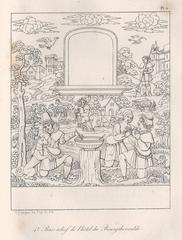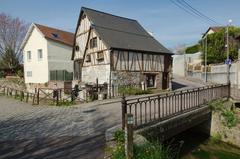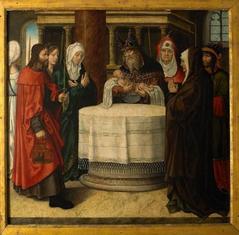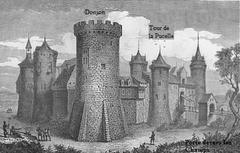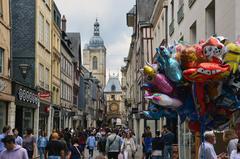Boulevard Jean-de-Béthencourt, Rouen, France: Visiting Hours, Tickets, and Historical Sites Guide
Date: 04/07/2025
Introduction
Boulevard Jean-de-Béthencourt in Rouen is a vital urban artery that intertwines the city’s maritime heritage, historical significance, and vibrant present-day culture. Named after the renowned Norman explorer Jean de Béthencourt, whose 15th-century expeditions to the Canary Islands represent an early chapter in European exploration, this boulevard stands as a testament to Rouen’s pride in its regional identity and global impact (Patrimoine Maritime Normand; Actu.fr).
Strategically located along the Seine’s left bank, the boulevard features broad, tree-lined avenues and offers easy access to Rouen’s medieval core and iconic landmarks such as Notre-Dame Cathedral, the Gros-Horloge, and Place du Vieux-Marché (Normandie Lovers; The Crazy Tourist). Supported by an efficient public transport network, including buses, trams, and a nearby ferry crossing, it’s an ideal starting point for exploring the city (Moovit).
More than a thoroughfare, Jean-de-Béthencourt Boulevard is a living tribute to Rouen’s maritime legacy and the spirit of exploration embodied by its namesake. Seasonal events, local markets, and nearby museums provide a rich cultural environment that deepens visitors’ understanding of Normandy’s historical significance (Gralon; Vitrines de Rouen).
This guide offers a comprehensive overview of the boulevard’s history, practical visitor information, nearby attractions, and cultural highlights to enrich your experience in Rouen.
Historical Background and Significance
Jean de Béthencourt: The Man Behind the Name
Jean de Béthencourt (1362–1425), born in Grainville-la-Teinturière near Rouen, was a Norman nobleman whose adventurous spirit led him to become a key figure in the early European exploration of the Atlantic. In 1402, he launched an expedition to the Canary Islands, successfully establishing control over Lanzarote, Fuerteventura, and parts of Gran Canaria, and founding the town of Betancuria on Fuerteventura (Patrimoine Maritime Normand). His diplomatic and military efforts, including the Christianization of local leaders, marked a pivotal moment in the region’s history.
The Boulevard’s Origins
Developed during Rouen’s urban expansion in the 19th and 20th centuries, Jean-de-Béthencourt Boulevard was conceived to improve access while commemorating Béthencourt’s legacy. The boulevard’s creation reflects Rouen’s tradition of honoring local historical figures and highlights the city’s maritime roots.
Symbolic and Urban Role
The boulevard is not only a thoroughfare but also a symbol of Rouen’s enduring connection to exploration and trade. Its strategic location and modern design contrast with the medieval streets nearby, offering a harmonious blend of history and contemporary urbanism (Normandie Lovers).
Visitor Information
Accessibility and Transportation
Jean-de-Béthencourt Boulevard is easily accessible via Rouen’s public transport system:
- Bus: Multiple lines stop nearby at the Cauchoise station, just a short walk away (Moovit).
- Tram/Metro: The Boulingrin station is the nearest tram stop, with frequent service.
- Ferry: The Ponton Pasteur ferry provides a scenic way to cross the Seine.
- Car: Pay-and-display parking is available nearby (Monday–Saturday, 9:00–19:00; free on Sundays and holidays). Evening flat rates and park-and-ride options are also offered (Rouen Parking Info).
Boulevard Access and Hours
- Hours: Open 24/7 as a public street.
- Tickets: No admission fee; access is free. Tickets are required only for nearby attractions.
Accessibility
The boulevard’s flat, wide avenues are pedestrian-friendly and accessible to people with disabilities. Public transport stations and parking options include provisions for reduced mobility.
Nearby Attractions and Cultural Highlights
Jean-de-Béthencourt Boulevard serves as a gateway to Rouen’s most celebrated sites:
- Notre-Dame Cathedral: Open daily, free entry, renowned for Gothic architecture and summer light shows (The Crazy Tourist).
- Gros-Horloge: 14th-century astronomical clock; tower visits require a ticket.
- Place du Vieux-Marché & Joan of Arc Sites: Open spaces, historic church, and museum dedicated to Joan of Arc.
- Abbatiale Saint-Ouen: Free entry, famous for its architecture and organ concerts (Normandie Lovers).
- Musée des Beaux-Arts: Free permanent collection, special exhibitions may have fees.
- Musée Maritime, Fluvial et Portuaire: Features exhibitions on Béthencourt and Rouen’s maritime history; open Tuesday to Sunday, 10 AM–6 PM, tickets approx. €7.
Markets, Gastronomy, and Leisure
- Local Markets: Place Saint-Marc and Place du Vieux-Marché (weekends, 8:00 AM–1:00 PM).
- Dining: Discover local specialties and renowned restaurants like La Couronne and L’Odas.
- Parks: Jardin des Plantes and Parc Grammont offer green spaces for relaxation.
Events and Festivities
- Médiévales de Rouen, Fêtes Jeanne d’Arc: Annual festivals with reenactments and markets (Médiévales de Rouen; Vitrines de Rouen).
- Les Samedis de Béthencourt: Concerts and workshops in the Hangar 107 district (Visiterouen.com).
- Rouen sur Mer: Summer events transforming the quays into lively recreational areas (Rouen.fr).
Practical Tips for Visitors
- Transport: Use the Moovit app for real-time public transit information.
- Best Times to Visit: Spring and early autumn for pleasant weather and lively markets.
- Safety: The area is well-patrolled, with a welcoming atmosphere.
- Language: French is primary, but English is widely spoken in tourist areas.
- Accessibility: Most modern attractions accommodate reduced mobility; check details for historic sites.
Frequently Asked Questions (FAQ)
Q: Is there an entrance fee or set visiting hours for Boulevard Jean-de-Béthencourt?
A: No, it is a public street open at all times, free of charge.
Q: How do I get there using public transport?
A: Multiple bus and tram lines serve the area; the nearest stops are Cauchoise (bus) and Boulingrin (tram/metro).
Q: What are the main nearby attractions?
A: Notre-Dame Cathedral, Gros-Horloge, Place du Vieux-Marché, and Musée Maritime are all within walking distance.
Q: Are events held on or near the boulevard?
A: Yes, from medieval festivals to summer beach events and concerts, the area is lively year-round.
Q: Is the area accessible for people with disabilities?
A: The boulevard and most amenities are accessible; some historic sites may have limited access.
Visuals and Media
Include high-quality images of the boulevard with descriptive alt text, such as “Jean-de-Béthencourt Boulevard in Rouen, a tree-lined avenue with easy access to historical sites.”
Interactive maps and virtual tours are available via the official Rouen Tourism and Normandy Tourism portals.
Summary and Final Recommendations
Boulevard Jean-de-Béthencourt is more than a central street in Rouen—it’s a living testament to the city’s maritime heritage, cultural vibrancy, and historical evolution. Freely accessible and ideally situated, it connects visitors to Rouen’s renowned sites, lively markets, and festive events (Patrimoine Maritime Normand; Actu.fr). Its thoughtful urban design offers comfort and accessibility for all travelers, while commemorative plaques and events celebrate the enduring legacy of Jean de Béthencourt.
For a richer experience, download the Audiala app for personalized guides and stay connected on social media for updates on Normandy’s cultural treasures. Begin your exploration of Rouen’s past and present at Boulevard Jean-de-Béthencourt, and discover the spirit of Norman adventure that continues to shape the city today.
